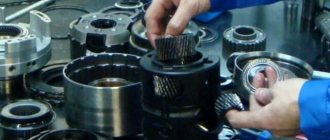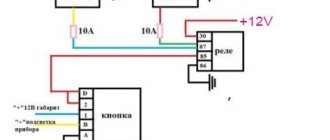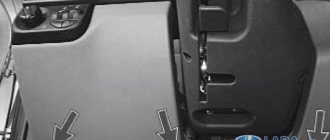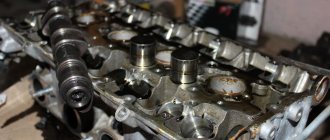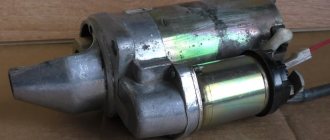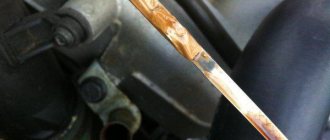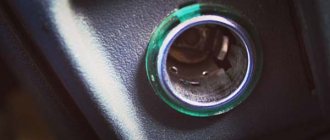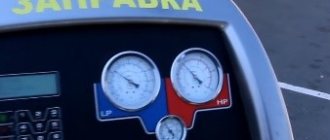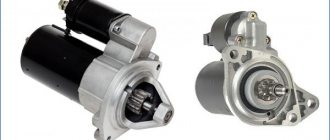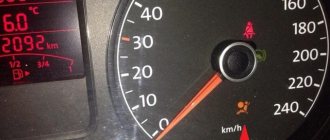The automatic transmission that is installed on modern cars is a rather complex unit. For this reason, its service life will directly depend on the quality of service.
Moreover, like any other device, an automatic transmission also has a strength limit, especially taking into account a number of design features. This means that the automatic transmission, depending on the degree of wear and condition, eventually begins to malfunction or fails.
At the same time, it is important to pay attention to certain signs that allow you to identify certain automatic transmission problems in time, after which you can carry out the necessary repair and restoration work at the lowest possible cost.
How to understand why the car “does not move”
Four common situations:
- The car does not start well and the starter takes a long time to turn.
- The car is unstable at idle.
- The car jerks when you sharply press the gas in 2nd or 3rd gear.
- The car does not pick up speed above 3000–4000 on the tachometer.
In the first three cases, if the contacts and “brains” are working properly, no error is displayed, check:
- candles,
- coils (and high-voltage wires, if any),
- fuel filter,
- gasoline pump.
In the fourth case the problem is more complicated.
Gear engaged: car does not move
So, quite often owners turn to transmission repair specialists with the problem “I turn the gear on, but the car doesn’t move.” In fact, the engine starts and idles normally, then the driver engages a gear and tries to start moving, but when the gear is engaged, the car does not move. Also, often when you try to add gas, the car engine simply stalls.
- Let's start with the manual transmission. First of all, you need to pay attention to whether there are jerks when releasing the clutch pedal. If this is the case, that is, the car jerks when trying to move when the clutch pedal is not fully released, and then the engine stalls after the clutch is fully released, you need to start with the simplest problems.
The cause may be a faulty handbrake (parking brake) or brakes. As a rule, a common cause is freezing of brake pads in winter. In this case, when you try to start, the wheels simply do not spin, the engine cannot cope with the load and stalls.
In order for the pads to “unstick”, you can try to move sharply by releasing the clutch pedal and adding gas. This helps break frozen pads. You can also warm up the mechanism with hot water by pouring water over the place where the pads are installed.
If freezing of the pads is excluded, then the brakes may jam as a result of malfunctions of the handbrake, in case of problems with the brake cylinders (the brakes jam), etc.
If the pads are in good condition and the brakes are working normally, you need to check the quality of the gear shift mechanism. A sign of problems with engaging first gear may be that after releasing the clutch the engine does not stall, but continues to run.
- It happens that the gearshift lever moves, but the gears simply do not engage. In this case, there is a high probability that the cable from the rocker to the gearshift lever has broken. In such a situation, instead of first, you can try to engage second gear or reverse, and then try to move away. If movement is impossible, the car needs to get to the repair site under its own power.
In the case when the gears are engaged normally, but the car does not move, the main reason is often a clutch failure. As a rule, if the clutch discs are “burnt” or the release bearing does not work normally, the clutch will be constantly disengaged. This leads to the fact that there is no connection with the engine and gearbox, torque is not transmitted to the gearbox, and the car does not move.
Another malfunction, which in practice does not occur so often, may be wheel drive problems. In such a situation, torque is transmitted to the gearbox, but there is no further transmission to the car's wheels. Naturally, the car stands still. It is necessary to check the condition of the drives, whether the internal
CV joint
(internal grenade), is there any damage to the CV joint, etc. If defects are found, you will not be able to move.
We also add that often the car cannot move if there are problems with the throttle or the car is equipped with an electronic accelerator pedal. In the first case, the throttle assembly must be inspected for damage, broken gas pedal cable, etc.
The electronic gas pedal does not have a direct connection with the throttle valve. This means that if the engine does not respond to pressing the gas pedal, the cause of the problem lies in the gas pedal position sensor, throttle position sensor, etc. On site, you can try to wash the throttle with carburetor cleaner, as dirt and carbon deposits interfere with the operation of the system.
Finally, we note that the car may not move and stall if the engine is “strangled” by a clogged catalyst. A decrease in the throughput of the catalytic converter leads to the fact that the engine can idle, but “chokes” after pressing the gas pedal, does not develop power, etc.
Tips and tricks
As you can see, if the automatic transmission is pushed, there may be several reasons, ranging from breakdowns of the gearbox itself or malfunctions of the ECM sensors to torn cushions (gearbox supports).
In other words, if the car jerks when switching the automatic transmission, the culprit may not be the gearbox at all, but bad fuel, problems with the power supply or ignition system.
If all the checks have been completed, but the cause of the failure has not been determined, then the transmission itself should be checked. Additional signs of problems with the automatic transmission are that the transmission goes into an “accident” (the automatic transmission goes into emergency mode), the automatic transmission jerks constantly and is noticeable when cold/hot, the automatic transmission slips, etc.
In such a situation, you should immediately visit a service station for in-depth diagnostics, since the gearbox itself is likely to break down. In this case, kicks and jerks may indicate problems with the clutches, gas turbine engine, valve body and other automatic transmission elements.
By the way, if it is not possible to immediately go to a service center, you should stop using the car until diagnostics and repairs are carried out, since further driving can lead to rapidly progressing breakdowns and serious and costly repairs of the automatic transmission.
Also, some drivers, especially those who do not have much experience in operating cars with automatic transmissions, immediately mistake light jolts from the automatic transmission for a malfunction. It should be remembered that the “classic” automatic transmission is not a continuously variable transmission (unlike CVT variators), that is, the transition from one stage to another is felt to a greater or lesser extent.
This means that for automatic transmissions, slight jolts when switching, especially when cold, are often the norm. Moreover, many automatic transmission modifications (regardless of the country of manufacture) are characterized by stronger shocks in certain modes.
For example, the transmission may push harder when the gas pedal is lightly pressed when shifting up from 1st to 2nd gear. At the same time, there may not be such shocks when moving higher (from 2 to 3, etc.). Also, the shocks will not be felt even from 1 to 2, if you accelerate more intensely, that is, press the accelerator pedal harder.
So, such light jolts of the automatic transmission are considered to be a feature of the unit’s operation. In simple words, the official dealers of different brands and experienced automatic transmission repairmen often do not consider this a malfunction, much less a reason for repairs. In this case, the boxes themselves also normally maintain their declared resource.
The car does not gain speed above 3000–4000
A failed catalyst or a second oxygen sensor (lambda probe) are two common problems why the car does not spin the engine above 3000-4000 rpm or picks it up slowly.
We recommend throwing out the “flying” catalyst and driving calmly, turning it off using chip tuning software.
If the problem is in the oxygen sensor, then the error message on the dashboard may or may not light up. It is highly undesirable to disable the first lambda. Basically, the ECU uses it to determine how to make the mixture. Disabling the first oxygen sensor increases fuel consumption.
The second lambda performs auxiliary functions and is intended to control the quality of the catalyst. More often than not, it comes to an end. The second oxygen sensor is disabled using chip tuning - “firmware for Euro-2”. After chipping, the operating algorithm changes, and the control system does not notice the presence or absence of a sensor.
Why should you disable the second oxygen sensor?
A faulty lambda probe “sticks” in one position and displays a fixed value instead of a sine wave. The engine adjusts the mixture and does it incorrectly. There are two ways out: remove the lambda probe physically, and flash the “brains” under EURO2, or replace it with a new sensor.
We do not take into account the option with decoys - this is a half-measure that leads to improper operation of the engine. After some time, the error appears on the dashboard again.
You might think that chip tuning is a panacea for all car problems. This is wrong. It solves environmental problems (oxygen sensors, USR, particulate filter) and adds “horses” to the car. The box will not be rebuilt and the valves will not be straightened. There is no need to wait for miracles.
When operating vehicles with different types of transmission (manual transmission, automatic transmission), the owner may encounter the fact that the car does not move when the gear is engaged. Mechanics, like automatic transmissions, can fail; the car does not move, although the gear is engaged.
As a rule, if the gears are engaged, but the car does not move, the main reason for the manual transmission is the clutch. In the case of an automatic transmission, there are more reasons; problems with the torque converter (the device also functions as a clutch), problems with the control electronics, or breakdowns of the box itself can be identified. Let's figure it out.
Read in this article
Video “How to determine the condition of an automatic transmission”
You will learn about ways to determine the condition of an automatic transmission from the video.
Reasons for automatic transmission slipping:
- Untimely replacement or use of low-quality transmission fluid. The problem is resolved by and;
- Failure. The problem is eliminated by replacing the disks with new ones by dismantling and repairing the box;
- Clogged/damaged channels, malfunction of the hydraulic system. The problem is eliminated by flushing the valve body using an ultrasonic stand and cleaning chemicals, as well as replacing the transmission fluid and oil filter.
- Failure of the pump (use of low-quality lubricating fluid).
The malfunction is detected by measuring the pressure in the lubrication system, which will correspond to the lowest mark. The problem is resolved by replacing the solenoid pack and/or pump. Reduced oil pressure in the automatic transmission lines (insufficient lubricant or faulty pressure regulator). The problem is solved by replacing the pressure regulator and partially or completely replacing the working transmission fluid. - Failure in the electronic components of the automatic transmission. With the help of high-quality and accurate diagnostics, the identified defect is eliminated (replacement of sensors, reprogramming or complete replacement, etc.).
Breakdown in the torque converter
The car does not drive if you do not monitor the machine:
- do not change the oil after the time specified by the manufacturer or experienced mechanics at the service station;
- wash the old automatic transmission filter and put it in place;
- Do not install an additional radiator on older cars;
- Do not pay attention to noises, shocks and jerks when idling and changing gears.
Problems not resolved above will lead to breakdown of the automatic transmission torque converter. This failure cannot be determined through diagnostics with a scanner. It is necessary to open the automatic transmission “donut” and visually inspect every detail.
Attention! I recommend visiting a service station annually for preventative maintenance. Such measures will help prevent problems with gas turbine engines. This means that you will save at least 20,000 rubles on repairing the automatic transmission torque converter.
Signs
New car owners often cannot distinguish the signs of a torque converter failure. And they blame it on bad oil, low-quality fuel. In fact, there are several symptoms due to which the car does not move due to a breakdown of the gas turbine engine:
- When you turn it on, you will hear noise in the automatic transmission. As the speed develops, it will disappear;
- The car starts, but does not drive. The splines on the turbine have worn out. By the way, the first symptom indicates the beginning of abrasion of these slots;
- you hear a metallic knock when you try to switch modes, and the car does not move;
- chips and other wear products on the dipstick;
- the engine stalls, the car does not move when you try to switch from one speed to another.
I have listed only some of the causes of malfunctions, due to which the car does not drive, related to the torque converter. When they appear, you should definitely visit the service center, so as not to completely change the “donut” later.
Remedies
What we can do to fix the problem and what you need to pay attention to if you understand automatic transmissions:
- You will have to remove the machine completely from the car.
- Disassemble the automatic transmission, pull it out and clamp it in a vise.
- Saw it in half.
- Examine seals, gaskets for cracks, holes in solid rubber. Replace them.
- Carefully inspect the turbine, pump wheel, and blades of these parts for wear or breakage. Replace if necessary.
- Assemble the torque converter and carry out balancing work. They are made on a special stand.
After the balancing is completed, you can install the gas turbine engine on the automatic transmission. And check whether the car runs or not after repair.
Attention! Be sure to check the torque converter housing for leaks after welding.
Diagnostics
Automatic transmission is popular today both in the domestic car market and in the foreign one. It has more than enough advantages, so it is not surprising that it is so popular. However, like any mechanism, it has the ability to break down. Most often you hear among car owners: the gearbox cannot change gears, you have to do it manually. We will talk about possible causes of failure and their diagnosis further.
First of all, before starting work, you should make sure that the problem is in the automatic transmission. That is, do all other car systems work properly if the engine cannot change gears? There are many problems that lead to a drop in the oil level in the gearbox. The main problem here is a violation of the tightness of the front automatic transmission oil seal.
Reasons for the drop in oil level in the automatic transmission:
In addition to these reasons, there are many other reasons for malfunctions of 4 and 5-speed gearboxes.
After overcoming the rise, the car can switch to a lower gear ahead of time.
Shifting forward is normal, moving backward does not occur.
When the lever is set to neutral, the car moves forward or backward.
Wear of either the working layer of the sliding bearing, or the aluminum washer, housing, etc.
Of course, these are not all the reasons for breakdowns of the automatic transmission itself, but they are the most common. In addition to these, there are also malfunctions of the electronic transmission system. Diagnosis of such problems does not require mechanical intervention in the car; they are detected using a scanner.
Most common faults
The main malfunctions that may occur during long-term operation of the vehicle:
- whistling sound;
- there is a characteristic noise when the power plant starts up;
- The automatic transmission does not engage when turned on;
- the car stalls when changing gears;
- the appearance of a specific smell from the selector;
- extraneous knocking noises when changing gears.
A whistling sound may be due to a torque converter problem. Also, you should pay attention to the fuel level in the box. Oil starvation leads to damage to the oil pump gears. If the pumping device fails, it will become impossible for the calipers to move, and extraneous sounds will appear from the gearshift lever.
The valve body ensures redistribution of transmission oil flows and pressure. Slips and impacts are the main signs that the automatic transmission valve body is broken. The valve needs to be flushed if it is dirty.
Possible options for why the hydraulic unit does not work:
- clogging of channels and valves with wear products;
- valve winding break;
- wear of the valve working surface.
It is unacceptable to drive a vehicle if there is a clanging sound from the side of the gearbox when the power plant is idling. It is necessary to check the integrity of the friction clutch discs. This spare part is responsible for blocking the elements of the planetary mechanism.
Automatic transmission repair is necessary if the integrity of the sealing gaskets has been compromised, which may result in oil leaks.
Any automatic transmission repair and restoration work should be carried out using appropriate tools. In particular, a set of heads, mandrels, wrenches, installation tools, etc. is required. Assembling and disassembling the box requires maximum care and precision.
How to avoid problems?
It must be said that the causes of automatic transmission malfunction can be both objective in nature, caused by physical wear, and can be caused by improper operation of this unit. Many car owners neglect the need to regularly change transmission oil, which leads to problems with lubrication and constant overheating of the automatic transmission. As a result, the moving elements of the box quickly fail and require expensive repairs.
It is also necessary to properly warm up the transmission in the winter, which will eliminate problems with lubrication of the moving elements of the transmission. Low-quality oil damages solenoids, the replacement of which is difficult and expensive. It should also be remembered that automatic transmissions are extremely critical to aggressive driving style. When the engine operates for a long time at maximum speed, the clutches of the automatic transmission can quickly burn out and wear down. That is why it is not recommended to constantly practice an aggressive driving style in a car with an automatic transmission.
The difficulty of repairing automatic transmissions is due to the fact that the failure can only be determined by opening the transmission. To do this, it must be removed from the car, which will allow us to determine the nature of the breakdown. It is not possible for most ordinary motorists to carry out high-quality repairs of an automatic transmission on their own, so it is necessary to contact specialized service centers. Repair work consists of replacing damaged elements, which allows you to restore the functionality of the entire automatic transmission. It should be noted that due to the structural complexity, automatic transmission repair is labor-intensive and high-cost.
Car service technicians distinguish
3 levels of diagnostics:
Self-medication here can be a routine oil change in the automatic transmission or setting the optimal oil level. This happens with four-speed engines that have traveled about 200,000 km.
At this level, a routine circuit check may help. This is a matter of a few minutes. A more serious problem can be identified by removing the pan. This is all inexpensive automatic transmission diagnostics.
Also, without dismantling, specialists can make a diagnosis using: a table test, checking the pressure on the line, checking the serviceability of the electrical wiring and reading fault codes.
If the automatic emergency mode (permanent 3rd gear) or any other fault listed below is obvious, then disassembly is necessary for a more accurate diagnosis. This is typical for boxes that have traveled more than 200,000 km. This mileage is approaching the time to replace the gas turbine clutch.
Defects with 100% accuracy will only be achieved by “opening” the automatic transmission.
We act correctly
In any case, if the machine is not working correctly, then you should entrust the solution to its problems to experienced and competent specialists. Our Automatic Transmission 03 team will diagnose your car (and completely free!), issue a verdict and, if necessary, undertake repairs to automatic transmissions of any complexity. Our main task is to solve the problem and save customers from transmission problems for years and hundreds of thousands of kilometers.
In automatic transmission hydraulics
The car does not drive, and the automatic transmission slips - the reason lies in the automatic transmission valve body. This is the most important part. Problems with the hydraulic plate arise due to dirty lubricant, clogged valve body channels, wear of channels and valves.
Signs
Signs of automatic transmission failure due to faults in the valve body, if the car does not move forward or backward, will be as follows:
- the car slips and does not move;
- When changing gears, knocking noises are heard and the driver feels jolts.
To eliminate problems due to which the car does not move or slips in place, you will need to disassemble the automatic transmission valve body.
Remedies
You will need to drive the car onto a pit or overpass. Then take the following steps:
- Drain all oil from the automatic transmission.
- Remove the pan and filter device.
- Unscrew the valve body bolts and remove it from the automatic transmission.
- Break it down into its components. Wash all five slabs.
- Replace solenoids that have failed.
- Reassemble and install into place in the automatic transmission.
Now you need to fill in fresh oil and install a new filter. The procedure for assembling and disassembling the valve body is not complicated and even a beginner can do it. More details can be found in our article specifically devoted to valve body repair. Check out the other articles in this section.
Prevention of automatic transmission breakdowns
In order for the vehicle owner to prevent malfunctions in the transmission, it is advisable to warm up the car before making a trip. In addition, it is necessary to monitor the transmission oil level. Each individual version of the car has its own deadline. It is important to replace the transmission if, during its routine check, wear products were found in the fuel. Also, oil starvation of the automotive system is unacceptable.
Towing over a short distance helps reduce the working life of the box. The resulting loads will negatively affect the components of the engine and transmission. When replacing components that have expired, you should use original, branded spare parts and filters.
Source
The machine does not move and stands still: reasons
If we talk about automatic transmissions, malfunctions often arise both in terms of electronics or hydraulics, and in terms of mechanics. For example, malfunctions in the automatic transmission control unit lead to the car not moving.
- In other words, if the car does not move when changing gears (modes), the control module may be the culprit. The cause may be damage to the unit, moisture ingress, voltage surges in the vehicle’s on-board network, exposure to vibrations, overheating of the unit, etc.
Also, in the event of a malfunction, the unit can transfer the box to
emergency mode
and completely block the transmission. In some situations, the engine does not start at all, while in others the engine starts at any position of the gearshift lever, but when mode D and/or R is activated, no starting occurs.
- Problems in the operation of the electrical part may also be due to the fact that electronic sensors fail. For example, an automatic transmission selector position sensor. If the element fails, the ECU simply does not “see” that the driver has moved the lever from position P to D. In this case, the car will not start moving. To find the cause, you need to check a number of automatic transmission controllers. To do this, you will need to conduct an in-depth diagnosis of the automatic transmission.
Another reason could be the torque converter. As a rule, when the gear is engaged, the car does not move as a result of breakdown of the thrust bearings of the gas turbine engine, loss of blades, malfunction of the overrunning clutch, etc.
If a car with an automatic transmission does not drive, you may notice the appearance of extraneous noises and knocks. The spline on the turbine wheel may be damaged; there may also be a malfunction in the bearing device between the reactor or turbine wheel and the donut cover of the automatic transmission.
Also, problems with the automatic transmission can lead to the torque converter locking up when trying to start. In this case, the car starts, but after switching the selector to “drive” mode, the engine stalls. To solve the problem, you need to remove and disassemble the torque converter, troubleshoot it, and replace worn or broken elements.
- As for the automatic transmission hydraulics, the car may not move due to breakdowns of the hydraulic unit. This occurs as a result of clogging of the valve body channels and valves with deposits and metal shavings. The valve return springs may also be weakened, the valve windings will short out, and the valves themselves will wear out.
The main symptoms are shocks and impacts when switching, then the problem progresses. Ultimately, the car starts, but does not go forward and/or reverse,
slippage appears
. In such a situation, the automatic transmission valve body needs to be flushed or repaired.
- Malfunctions of the mechanical part of the automatic transmission are considered one of the most serious. The pump, clutches, planetary gears, etc. may fail. If, when you try to start moving, it is impossible to move, and the box vibrates strongly, shocks, metallic knocks, rattles, vibrations, etc. are noticeable, the engine should be turned off, since the automatic transmission needs to be repaired.
Video “Instructions for disassembling an automatic transmission”
User Alexander Sorokin showed in his video how the procedure for disassembling and repairing a transmission is performed in a garage.
If your car equipped with an automatic transmission does not move forward or backward, in order to identify faults and further eliminate them, it is necessary to conduct a full diagnosis of the automatic transmission. Most often, these malfunctions are accompanied by the appearance of “errors” and a transition to emergency mode.
This malfunction can manifest itself in different ways: - there is no main pressure - there is no movement back and forth - there is no movement either backwards or forwards, there is no 3rd speed - the car does not move, there is no reaction to switching modes - there is no forward movement, the car is slipping in place - no movement back
Causes of these malfunctions: - antifreeze getting into the oil cooler
, in this case, you will find an emulsion in the ATF of the transmission - troubleshooting and major repairs of the automatic transmission are necessary -
wear of the friction discs of the forward or reverse clutch - wear of the piston cuff - wear of the oil sealing rings - the valve for switching from 1st to 2nd speed is stuck
- the car goes backwards, but does not go forward and slips
the spline connection in the sun gear drum housing is cut off
- the car does not go backwards -
wear and malfunction of the pump, bushings, gears
(mechanical part of the automatic transmission) -
malfunction of the brake band - rupture of the cuffs on the clutch and damage brake band piston rod
- no reverse movement
- torque converter malfunction - wear of splines
- no movement, slipping
To avoid these breakdowns, it is necessary to service the automatic transmission on time - change the oil and filter every 50-80 thousand km. mileage or at least once every 2-3 years (whichever comes first
Malfunction of fork and clutch discs
The car does not move forward if the clutch discs and clutches responsible for transmission are faulty. The car cannot change from one gear to another. Sometimes not only the internal parts of the automatic transmission fail, but also the external ones that connect it to the engine. Repair of the fork and clutch discs must be carried out as quickly as possible, since their incorrect operation accelerates the wear of other parts.
Signs
Signs that will tell you that the fork and clutch discs have failed are the following:
- the car does not move when the automatic transmission is engaged in reverse gear;
- slipping during gear shifting;
- when cold, the car switches from speed to speed normally, as soon as the automatic transmission starts to warm up, the car does not pick up speed above 2nd gear or does not go at all;
- switching occurs with powerful blows, not jolts.
The car must be driven to a service station or garage using a tow truck if it does not drive, and the faulty part must be removed and a new one installed.
Remedies
To fix problems with the fork and clutch discs, you will need to completely disassemble the automatic transmission. Remove the clutch and piston assembly from the box. Steel discs must be replaced in batches, not one at a time, since a half-worn first disc can lead to rapid wear of the new disc installed.
Write in the comments how you got rid of problems with automatic transmission if the car does not drive? By yourself or with the help of mechanics at a service station? Was it difficult if you did the work yourself?
What to do if a car with an automatic transmission does not move backwards: advice from an auto expert
Hello! Please tell me, my car (automatic transmission) does not go backwards. More precisely, when turning on reverse gear, if the gas pedal is pressed all the way, it starts to move with difficulty. It goes forward without any problems. What could this be and what should I do? (Marina)
Hello, Marina. We have analyzed your breakdown and are ready to help you with some advice.
Why doesn't the car go backwards?
There may be several reasons for this. All of them are listed below:
- the gear shift device itself is faulty;
- there is a breakdown or defect in the valves in the hydraulic plate;
- clutches are out of order;
- incorrect transmission fluid pressure level;
- The oil in the box has run out.
As you understand, you need to build on this. Turning on the reverse does not depend on the electrics, so, most likely, everything is in order with your wiring. But we cannot guarantee this to you, since we have not seen your car and have not diagnosed it.
In any case, you need to seek help from the service, since you cannot solve the problem yourself without the necessary equipment. First of all, the vehicle's gearbox must be checked for errors. During diagnostics, you will receive fault codes that will have to be deciphered to understand what the problem is. After all, perhaps the problem lies in the breakdown of one of the devices responsible for turning on the reverse speed.
Loading .
It is also a good idea to check the transmission oil level in the automatic transmission. Sometimes the problem is a lack of fluid. Perhaps replacing it or adding it to the required level will solve the problem. But you should remember that under no circumstances should you do as you do. This means pressing the gas pedal when the reverse gear is not working. If the problem is in any device, then with such actions you can simply finish off the box and it will completely fail. In any case, the first thing to do is to carry out computer diagnostics of the car.
Video “How to determine the condition of an automatic transmission”
You will learn about ways to determine the condition of an automatic transmission from the video.
Question
Iverson
- in the sandbox
- Users 200
- 0
- 8 messages
- City:St. Petersburg
Greetings to everyone! I recently became the owner of a new Forika 2.0L on the handle. In winter conditions, due to inexperience, I burned the clutch, trying to get out of a snowdrift (this was two days ago). There was a smell and smoke. Yesterday, when trying to park in the yard, the car stopped dead in its tracks. Those. the smell has appeared, there is a little smoke (but not like before), the gears are engaged, but when you give the gas, the speed rises, and the car stands rooted to the spot. What could it be? Clutch or something else? And the tow truck can’t even get to my yard.
andre
- Users 500
- 0
- 1,095 messages
- Name: Andrey
- City:St. Petersburg
Iverson
- in the sandbox
- Users 200
- 0
- 8 messages
- City:St. Petersburg
Yes, it’s clear what it will show! Can’t get to the “hospital” ((
andre
- Users 500
- 0
- 1,095 messages
- Name: Andrey
- City:St. Petersburg
pull it onto the road, and then onto a tow truck.
Janek
- Users 500
- 0
- 1,600 messages
- City:St. Petersburg
- Car:SUBARU FORESTER 07, 2.0, atmospheric, handle + wad308
Greetings to everyone! I recently became the owner of a new Forika 2.0L on the handle. In winter conditions, due to inexperience, I burned the clutch, trying to get out of a snowdrift (this was two days ago). There was a smell and smoke. Yesterday, when trying to park in the yard, the car stopped dead in its tracks. Those. the smell has appeared, there is a little smoke (but not like before), the gears are engaged, but when you give the gas, the speed rises, and the car stands rooted to the spot. What could it be? Clutch or something else? And the tow truck can’t even get to my yard.
Sorry for the stupid advice, but... Look at the lowering switch - I could have touched it and it took the middle position. I had tacos at the car wash - by the time I realized what was going on, I was sweating.
Uralets
Greetings to everyone! I recently became the owner of a new Forika 2.0L on the handle. In winter conditions, due to inexperience, I burned the clutch, trying to get out of a snowdrift (this was two days ago). There was a smell and smoke. Yesterday, when trying to park in the yard, the car stopped dead in its tracks. Those. the smell has appeared, there is a little smoke (but not like before), the gears are engaged, but when you give the gas, the speed rises, and the car stands rooted to the spot. What could it be? Clutch or something else? And the tow truck can’t even get to my yard.
Sorry for the stupid advice, but... Look at the lowering switch - I could have touched it and it took the middle position. I had tacos at the car wash - by the time I realized what was going on, I was sweating.
+1 yeah....also “sweated” a couple of times
( 2 ratings, average 4 out of 5 )
How to prevent breakdown
To avoid all the problems described, at least in the first 200,000 kilometers, it is important to follow the rules for operating an automatic gearbox:
- in the cold season, warm up the automatic transmission for 5 or 10 minutes;
- do not start abruptly and when it is cold. Automatic machines do not like hard starts, especially CVTs;
- change the oil and filter device every 30,000 thousand kilometers;
- fill only original oil and avoid fakes;
- replace the lubricant after 60,000 thousand kilometers using the replacement method;
- Do not carry cargo or other vehicles on a machine with a gun using a trailer;
- do not skid on icy roads in winter or on snowy roads in snowdrifts;
- Warm up the box even in summer so that the oil stops being viscous and easily seeps into all automatic transmission components.
Only following these rules will allow you to avoid costly repairs.
The automatic transmission is slipping: what to do?
How to diagnose
Slipping of an automatic transmission can be determined by noise and incorrect behavior of the car when switching gear modes. It is not recommended to diagnose automatic transmissions in a garage; professional help is needed here.
The most common way to identify faults is computer diagnostics. By the way, it is the most accurate and allows you to localize a fault in a short time based on the error codes issued by the system.
Repairing an automatic transmission is a complicated matter; in most cases it requires dismantling the unit. Only after this the preliminary diagnosis issued by the electronics can be confirmed or refuted.
Source
I press the trigger to the floor, but the car doesn’t move, only the engine roars: I’m finding out the reason
How many interesting projects have sunk into oblivion after the collapse of the USSR! We have already talked about the concepts from GAZ and AvtoVAZ, which remained on paper. Next up is IZH and his Jaguar project.
The Ulyanovsk Automobile Plant spent about 15 years developing the UAZ-3907. The vehicle was even accepted into service, but due to the total devastation and chaos that was happening around, it was never released.
Oh, how much time and labor was wasted... But the Ulyanovsk plant could become famous throughout the world if the Jaguar amphibious vehicle had been brought to fruition and its production put into production. By the way, the name is very conditional - the car looks like a crocodile.
Source: kolesa.ru
Back to the 70s. How the UAZ-3907 was created
Let's go back to 1977. The Ministry of Defense sets UAZ a difficult task - to develop a universal vehicle in the shortest possible time. It must move not only on land, but also on water, function perfectly even in 40-degree frost, and be easily repaired using available tools.
Source: kolesa.ru
The project was codenamed "Jaguar". This is the only animal from the cat family that is not afraid of water and is an excellent swimmer. The Ministry of Defense also emphasized that the car must carry up to 7 people or a load weighing 600 kg, and be able to tow a trailer. Already in 1980, they managed to make a couple of models, but by 1989 only 14 samples had been assembled.
Source: kolesa.ru
Why so long? First of all, because of the meticulous work on the design. At first, the amphibian was equipped with a conventional UMZ-414 engine with a power of 77 hp. It was replaced by a 90-horsepower engine, and in the end it all ended with the UMZ-421 with a capacity of 103 horsepower. The serial “Loaf” was equipped with a modernized gearbox only in the late 80s. Whereas the Jaguar drove with such a gearbox 8 years earlier. The development of the transmission was carried out jointly with US.
Where did the Jaguar go?
The first models had two steering wheels. One was intended for control on land, the second - for water. Subsequently, engineers realized that they could limit themselves to one steering wheel. The car was also equipped with:
- Several propellers with 4 blades. They were located in front of the rear axle.
- All-metal body. The frame was welded.
- Safety bars.
- Removable soft awning.
The first tests of the UAZ-3907 were successful. The amphibious vehicle managed to sail from Ulyanovsk to Astrakhan along the Volga River and successfully return back. In water it reached speeds of up to 8 kilometers per hour, and on land it accelerated to 100 km/h. By 1991, the model was put into service and ready for mass production.
However, what had to happen happened. The Soviet Union collapsed and funding for the project was stopped. The Ulyanovsk plant did not try to pull out the Jaguar alone. Therefore, the project was frozen, most of the documentation was destroyed at the request of the “people in caps.”
Box repair or contract
Now many will tell me that it is better to buy a contract one and not have to worry about repairs. I agree with this proposal only when the design features of the automatic transmission or the decrepitude of the device do not allow for competent repairs. If the car's transmission is recent, then it is better to overhaul the car's automatic transmission.
You will ask why?". Because when you buy a contract one, you may be buying a restored “drowned car”. They won't tell you this. It is not a fact that the operation of such a box will last for ten years. In my experience, such boxes last a little longer than the stated warranty period.
